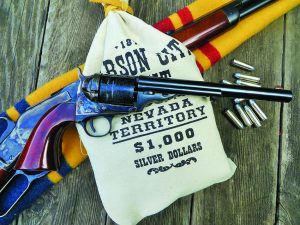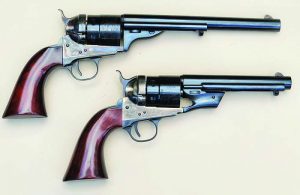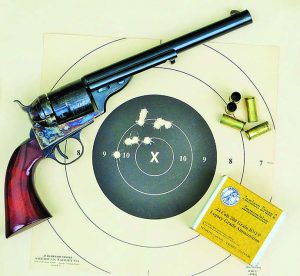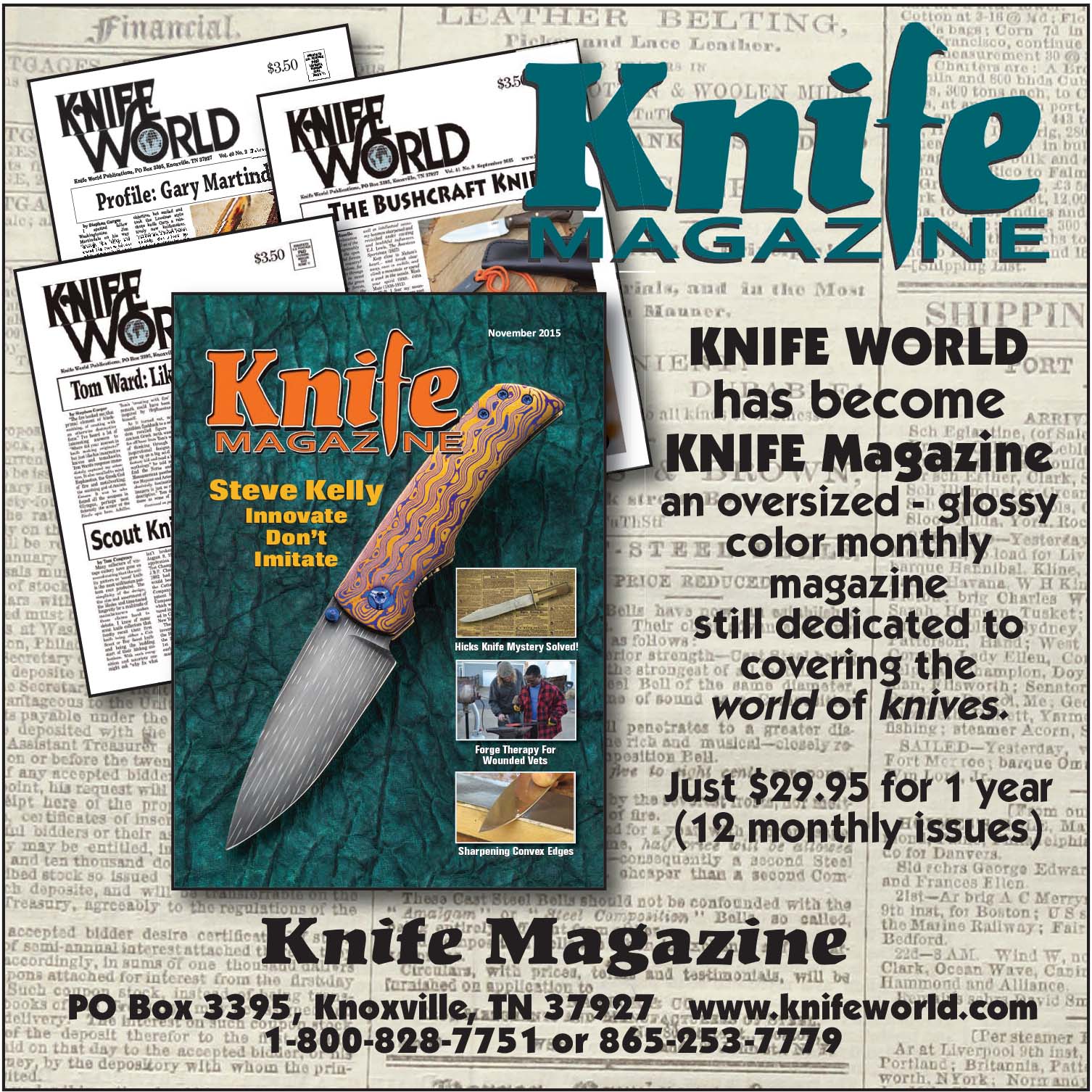by Mike Nesbitt | Contributing Editor

Cimarron’s open-top revolvers bring back some real flavor of the Old West.
Cimarron Firearms Company is recognized as a leader in quality and authenticity for replica firearms. Since 1984 they have worked hard to bring replicas into this country that represent the best in authentic detail, fit, and finish in addition to the function and performance of the frontier-style firearms. We find those qualifications to be quite impressive with the guns being featured here, these two .44 Colt caliber revolvers.
The evolution or “stepping stones” in the transition from percussion revolvers to cartridge firing six-guns is very interesting. I’m mainly thinking of the Colt revolvers when saying this. Also, when I got interested in these six-guns from Cimarron, at first it was because they could fire the .44 Russian cartridges. They will do that, very nicely too. But now that I’ve gotten some experience with the guns my personal favorite loads changed to the .44 Colt cartridges.

The 8” barreled gun is the Richards-Mason and the shorter is the Richards Type II.
One reason for this is certainly historically based because the old .44 Colt is the cartridge several of the original conversion revolvers were chambered for. Another popular cartridge for the Colt conversions was the .44 Henry rimfire. Those two cartridges were actually rather similar with the exception of their style of ignition. The .44 Colt was a centerfire cartridge that used a heeled bullet of 210-225 grains over up to 21-28 grains of black powder which was introduced in 1871. That’s a very hasty description of this old cartridge and it was used by the US Army for a couple of years, prior to the adoption of the .45 Colt in 1873.
The .44 Colt saw plenty of civilian use too and the “conversion” or open-top revolvers were made by Colt up until 1877 or so, and they were less expensive to buy than the new and hard to get Single Action Army.
Cimarron has a wide variety of “conversion revolvers” and the .44 Colt was selected for authenticity. Two of those revolvers ended up in this camp, a Richards Type II conversion with a 5½” barrel and the Richards-Mason conversion with an 8” barrel. These were advertised as being chambered for the .44 Colt/Russian because they will also shoot the .44 Russian cartridges. (In fact, they’ll chamber the .44 Special cartridges.)
These new revolvers from Cimarron deserve a good looking at. One tiny feature that delighted me was the very light and nice trigger pulls on both guns. Previous experience with imported replicas made me expect stiffer springs and much harder trigger pulls. Not so with these. That’s a very positive thing.

A good 10-shot group fired with Jamison .44 Colt ammo.
Both of these guns have the rear sighting notch cut into the top of the hammer, which can’t be seen unless the hammer is in the cocked position. (The Model 1872 Open Top revolver has the rear sight on top of the barrel just forward of the cylinder.)
There is a question about whether these revolvers should be fired with only black powder loads. The Instruction Manual for these new guns says, “Make certain you are using only new commercially loaded ammunition of the correct caliber. (Warning: DO NOT use ammunition marked “High Speed” or “High Velocity” and NEVER use reloaded ammunition.)” Later in the same manual comments are made to use new ammunition manufactured to industry specifications. With these statements we can be rather sure that smokeless powder loads are certainly acceptable.
About never using reloaded ammunition; I broke that rule from the manual with the very first shot.
A standard pistol target was posted at just 12 yards and my very first five shots with the 8” barreled gun were taken while firing the gun one-handed. Those five rounds, handloaded .44 Russians with 250 grain round nose bullets but loads were a mixture: three of the rounds were smokeless loads and two of them were black powder. It was easy to tell the difference between those loadings in smoke, flame, and the gun’s recoil but they all hit very nicely. My target would have scored 49-X but I was much more impressed with the group size and the fact that this revolver was hitting right at the point of aim.
My partner, Lynn Willecke, did about the same with the 5½” barreled .44, saying, “These things are right on, right out of the box!” After that we quit shooting paper and turned our attention to metal knock-down targets. That was simply a lot of fun. Lynn and I were taking turns and just keeping mental note of who missed first. Let me say, with just a little bragging involved, I won. In fact, at that short shooting session I never missed.
For shooting with the .44 Colt cartridges, more details must be given. We loaded some of the Starline .44 Colt cases with 25 grains of Olde Eynsford 2F under Lyman’s .44/40 bullet, #427098. That was a good stout load which must come fairly close to the original .44 Colt loads. However, we were using bullets with their grease grooves inside the cartridge cases and the old original .44 Colts had outside lubricated bullets. In addition to having a good bellow to it, those black powder .44 Colt loads hit very well.
Jamison Brass & Ammunition loads .44 Colts (using Starline cases) with a 200 grain round nose flat point lead bullet which is also very accurate. As part of Jamison’s “Legacy Grade Ammunition” the .44 Colts join other rifle and revolver cartridges such as the .44/40 and a fairly long list of others. Good ammo, for sure.
And I prepared a few rounds with a charge of 5.5 grains of Unique under the .44/40 cast bullets. Those proved to be very light in recoil and very pleasing to shoot. It’s a good bet that a load similar to that will become my “standard” loading for the 8” barreled Richards-Mason conversion by Cimarron Arms
One tiny feature that both Lynn and I appreciate about these revolvers is that they are marked “Cal .44 Colt” on the underside of the barrels. We were told by Cimarron that newer guns might not carry that mark because they are considering making all of their .44 revolvers chambered for the .44 Special cartridge. The .44 Special is just about .05” longer than the .44 Colt and we can understand the practicality of Cimarron’s idea. At the same time, we’re just old fashioned enough to hope they do keep the .44 Colt designation. And, just because we did try them, .44 Special cartridges drop into the chambers on these two six-guns quite easily.
Cimarron’s renditions of the old Colt conversion revolvers are available in several configurations. They can be had with Army grips, Navy grips, with 4¾, 5½, 7 ½, or 8-inch long barrels and in calibers such as .38 Special, the .44s like we selected, and either .45 Schofield or .45 Colt. In our narrow (and perhaps narrow-minded) review we have commented only on the .44 Colt version which was our choice and certainly the most authentic. Not all versions are available in all of those calibers or barrel lengths so if you have an interest for more information by all means go to the Cimarron web site atcimarron-firearms.com. Cimarron’s price for the Richards-Mason conversion revolvers is $583.70 and for the Type II conversions the price is $616.20. We’ll tell you, these two are a lot of gun for the money.




